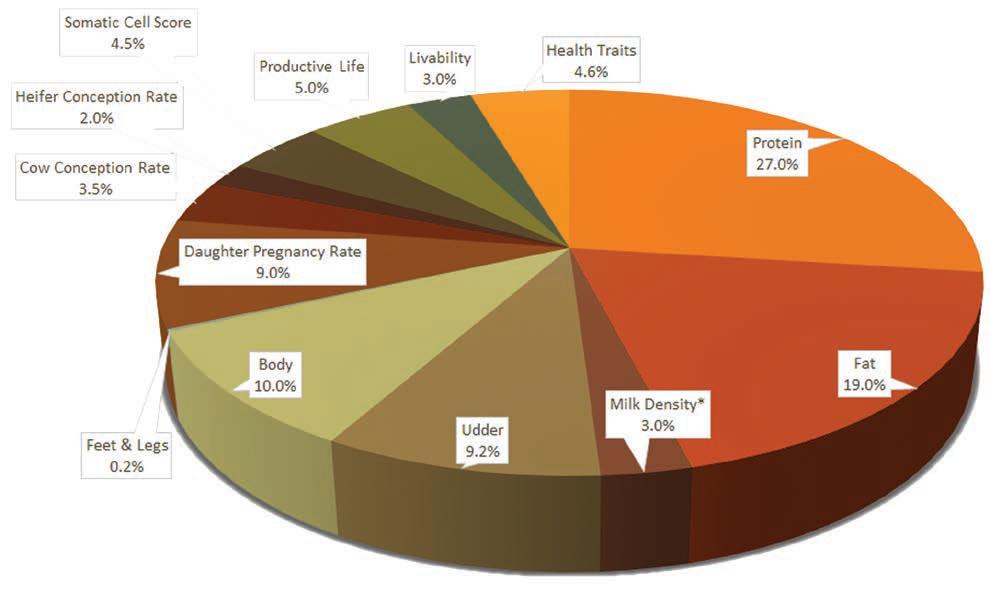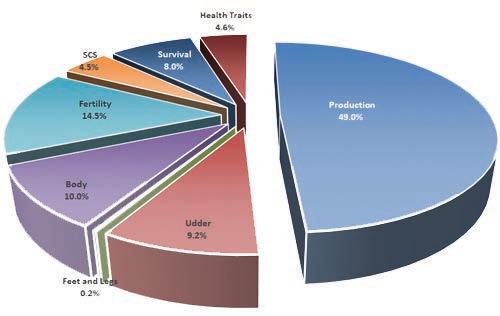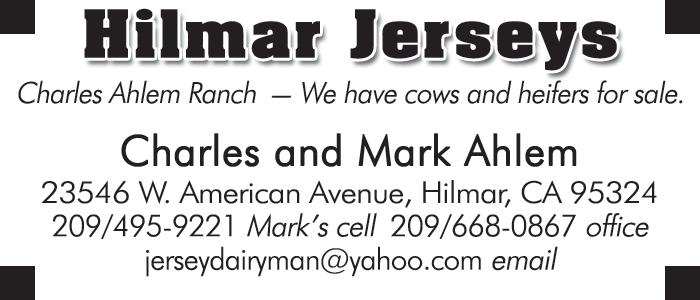
4 minute read
Jersey Performance Index to be Updated for April Evaluations
At its regular meeting March 14, 2020, the AJCA Board of Directors authorized updates to Jersey Performance Index TM , adding new traits to the index and adjusting weights for previously included traits. The revised JPI 2020 will be implemented with the April 2020 genetic evaluations. Some rescaling and re-ranking is to be expected as the number of components has been increased, Jersey health traits have been added and new economic weights and standard deviations have been applied.
JPI predicts the efficiency of production by expressing lifetime production of fat and protein per unit of feed consumed. Traits and their weights in JPI 2020 , with changes from the previous version noted in parentheses, are 27% PTA protein (-3%); 19% PTA fat (+4%); -3% Milk Density* (-5%); 19.4% Functional Trait Index (subsets are Jersey Udder Index TM , Feet and Legs and Body); 14.5% Fertility (includes 9% Daughter Pregnancy Rate (+2%), 3.5% Cow Conception Rate (+1.5%) and 2% Heifer Conception Rate); 8% Survival (subsets includes 5% Productive Life (-1%) and 3% Livability (-1%)); 4.5% Somatic Cell Score (-1.5%); and six new Jersey Health Traits at 4.6% (Milk Fever 1.0%; Displaced Abomasum 1.0%; Ketosis 0.4%; Mastitis 1.9%; Metritis 0.2% and Retained Placenta 0.1.%). (Fig. 1)
*Milk Density is calculated by subtracting the sum of PTA Protein and PTA Fat divided by .09 from PTA Milk.
New Jersey Health Traits The April genetic evaluations will mark the release of six health traits that will help alleviate costly health conditions impacting Jerseys. The traits will help build resistance against displaced abomasum, milk fever, ketosis, mastitis, metritis and retained placenta.
PTAs for each of the health traits will be the predicted daughter difference for resistance above or below the Jersey breed average. The larger the positive values, the more favorable the genetic resistance to the disorder. The genetic evaluations can help identify individuals that transmit costly difference and help manage their use in breeding programs.
The traits and their weightings are listed below. • Milk Fever or Hypocalcemia: (1.0%) Typically results after calving due to low total blood calcium levels. • Displaced abomasum: (1.0%) Enlargement of the abomasum with fluid and/or gas that caused its movement to the left or right of the abdominal cavity; the twisting blocks the digestive process and usually requires veterinary intervention. • Ketosis: (0.4%) Build-up of ketone bodies that typically occurs due to negative energy balance in early lactation. • Mastitis: (1.9%) Infectious disease that causes inflammation of the mammary gland; one of the most common and costly diseases of dairy cattle. • Metritis: (0.2%) Infection of the endometrium (lining of the uterus) after calving. • Retained placenta: (0.1%) Retention of fetal membranes more than 24 hours after calving.
Improving Jersey’s Sustainability In 2017, CFP Milk (now Milk Density) and a significant penalty on body size through Body Weight Composite was added and applied the key principles of Jersey sustainability identified by researchers Jude Capper and Roger Cady in their 2012 study. Lower total body mass of the Jersey reduces maintenance costs per animal and the great nutrient density of Jersey milk dilutes maintenance resource requirements. Going forward, they concluded that the three primary drivers of dairy cow sustainability are production, milk nutrient density, and body size. Jerseys need to increase milk yield, maintain—or better improve—component levels, and maintain body size. This focus was retained for 2020, as well as focusing on the Lifetime Efficiency of the Jersey cow.
Learn more about the Jersey Performance Index 2020 update at Green Book Online (http://greenbook.usjersey.com).
Fig. 1. Weights for components included in 2020 update of Jersey Performance Index TM (JPI TM ).

Fig. 2. Weights for main categories included in 2020 update of Jersey Performance Index TM (JPI TM ).



Richard Clauss and Family 21672 Bloss Ave. Hilmar, CA 95324 209/632-3333 claussjerz@yahoo.com






JULY 10—WISCONSIN JERSEY STATE SHOW AND JERSEY FUTURITY, Alliant Energy Center, Madison, Wis. JULY 25-29—CALIFORNIA STATE FAIR, Sacramento, Calif. AUG. 14—IOWA STATE FAIR JERSEY SHOW; Iowa State Fairgrounds, Des Moines, Iowa; 9:00 a.m. (CDT). AUG. 16—INDIANA STATE FAIR JUNIOR JERSEY SHOW, Indiana State Fairgrounds, Indianapolis, Ind., 8:00 a.m. (EDT) AUG. 19—INDIANA STATE FAIR OPEN JERSEY SHOW, Indiana State Fairgrounds, Indianapolis, Ind., 8:00 a.m. (EDT). SEPT. 14—MID-ATLANTIC REGIONAL JUNIOR JERSEY SHOW, Pennsylvania Farm Show Complex and Expo Center, Harrisburg, Pa.; 8:00 a.m. (EDT). SEPT. 15—MID-ATLANTIC REGIONAL OPEN JERSEY SHOW, Pennsylvania Farm Show Complex, Harrisburg, Pa.; 12:00 p.m. (EDT). SEPT. 29—INTERNATIONAL JERSEY SHOW, Heifers, Alliant Energy Center, Madison, Wis.; 3:00 p.m. (CDT); Chad Ryan, Fond du Lac, Wis., judge; Kevin Doebriener, West Salem, Ohio, associate. SEPT. 30—INTERNATIONAL JERSEY SHOW, Cows, Alliant Energy Center, Madison, Wis.; 7:30 a.m. (CDT); Chad Ryan, Fond du Lac, Wis., judge; Kevin Doebriener, West Salem, Ohio, associate. NOV. 7—THE ALL AMERICAN JUNIOR JERSEY SHOW, Kentucky Fair and Exposition Center, Louisville, Ky.; 7:30 a.m. (EST). NOV. 8—NATIONAL JERSEY JUG FUTURITY, Kentucky Fair and Exposition Center, Louisville, Ky.; 1:30 p.m. (EST). NOV. 9—THE ALL AMERICAN JERSEY SHOW, Kentucky Fair and Exposition Center, Louisville, Ky.; 7:30 a.m. (EST).








